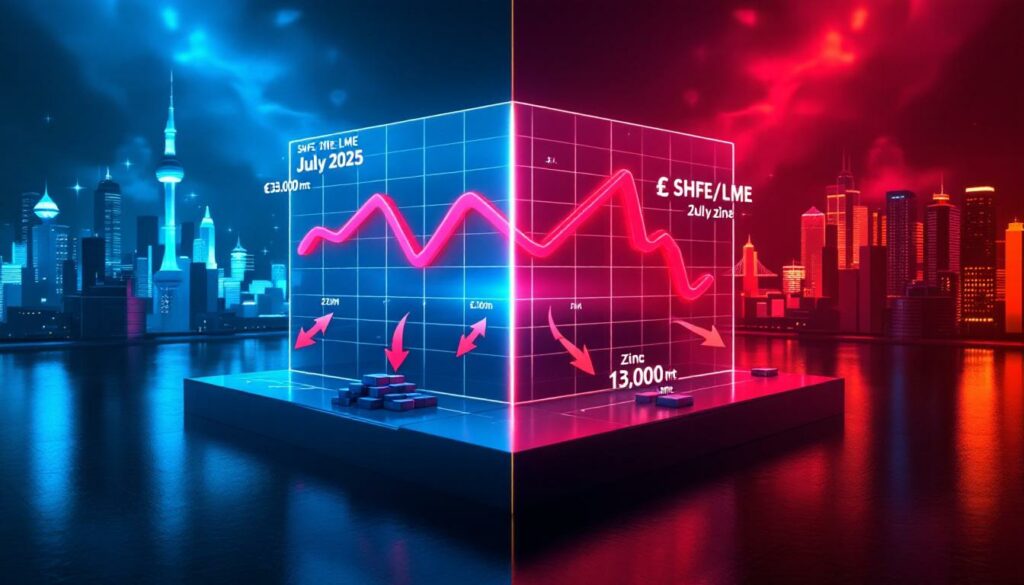Understanding the SHFE/LME Zinc Price Ratio and Its Market Impact
The relationship between Shanghai Futures Exchange (SHFE) and London Metal Exchange (LME) zinc prices represents one of the most critical metrics in global metals trading. This price ratio serves as both a barometer for market conditions and a trigger for international trade flows that shape the global zinc supply chain.
Definition and Importance
The SHFE/LME zinc price ratio is calculated by dividing the zinc price on the Shanghai Futures Exchange by the corresponding price on the London Metal Exchange, after accounting for currency conversion. This mathematical relationship might seem straightforward, but it carries profound implications for the entire zinc ecosystem.
Historically, this ratio has oscillated between 7.0 and 8.5 under normal market conditions, with values above 8.0 typically signaling favorable conditions for importing zinc concentrates into China. When the ratio falls below critical thresholds, as observed in mid-2025, market dynamics shift dramatically.
"The ratio serves as the invisible hand guiding global zinc flows, determining whether metal moves east or west in response to regional price disparities." – Shanghai Metal Market Analysis
How the Ratio Affects Global Zinc Trade
The SHFE/LME ratio creates arbitrage opportunities that drive physical metal movements. When Chinese prices rise relative to international benchmarks (higher ratio), imports become economically attractive. Conversely, when the ratio deteriorates, as reported in July 2025, import interest wanes significantly.
This mathematical relationship effectively functions as an early warning system for broader market trends, often signaling shifts in regional supply-demand balances before they become apparent in other metrics. Furthermore, the commodities trade volatility influenced by this ratio creates both challenges and opportunities for market participants.
How Is the SHFE/LME Zinc Price Ratio Currently Performing?
The SHFE/LME zinc price ratio has experienced a pronounced decline through July 2025, continuing a deteriorating trend that has significantly impacted market behavior across the zinc value chain.
Recent Ratio Trends
According to Shanghai Metal Market (SMM) analysis from July 11, 2025, the ratio's continued deterioration has directly corresponded with sluggish transactions in imported zinc ore markets. While specific numerical values weren't disclosed, the decline has clearly crossed critical thresholds that affect trading behavior.
This decline stands in contrast to historical patterns where ratio fluctuations typically reflect seasonal demand cycles and regional production costs. The current trajectory suggests deeper structural factors affecting market equilibrium, similar to what analysts have observed in recent iron ore price forecast scenarios.
| Period | SHFE/LME Ratio Trend | Market Response |
|---|---|---|
| Q1 2025 | Relatively stable | Normal import flows |
| Q2 2025 | Gradual decline | Reduced import enthusiasm |
| July 2025 | Accelerated deterioration | Sluggish transactions, minimal trader interest |
Market Implications of the Deteriorating Ratio
The ratio's decline has triggered a cascade of effects throughout the zinc supply chain. Most notably:
- Reduced Import Interest: Chinese smelters have shown diminished interest in foreign concentrate due to the unfavorable economics created by the lower ratio.
- Trader Hesitation: Market participants have displayed "low enthusiasm for offering zinc ore" specifically citing the deteriorating ratio as the primary cause (SMM News, July 11, 2025).
- Price Divergence: The gap between domestic and imported zinc concentrate treatment charges has widened, with imported TCs rising while domestic charges remain stable.
These developments reflect how price signals through the ratio mechanism effectively regulate international metal flows, directing material to markets where it commands the highest relative value.
What Factors Are Driving the Current SHFE/LME Zinc Price Divergence?
Multiple forces have converged to create the current price divergence between Chinese and international zinc markets, with supply-side developments playing a particularly significant role.
Supply-Side Influences
Global zinc concentrate production has seen notable developments that influence regional pricing dynamics:
-
Kipushi Mine Production: Ivanhoe Mines reported Q2 2025 production of 41,800 metric tons of zinc concentrates from its Kipushi operation in the Democratic Republic of Congo. However, June processing volumes decreased due to a 9-day shutdown for equipment upgrades to address "excessive ore powder content" in the Dense Media Separation (DMS) system.
-
Chinese Port Inventories: As of July 11, 2025, zinc concentrate inventories at China's main ports stood at 333,000 metric tons, representing a modest week-over-week decrease of 1,000 metric tons. This relative stability in port stocks suggests that physical tightness isn't the primary driver of current market dynamics.
-
Smelter Raw Material Positions: Chinese smelters reported "sufficient raw materials" according to SMM analysis, indicating adequate short-term supply coverage that reduces import necessity despite changing price relationships.
Demand-Side Pressures
Regional consumption patterns have created divergent price pressures:
-
Seasonal Factors: Mid-year typically represents a transitional period in Chinese zinc demand as construction activity faces summer slowdowns while manufacturers prepare for autumn production increases.
-
Downstream Industry Activity: While not explicitly quantified in recent reports, variations in galvanizing sector activity (representing approximately 60% of zinc consumption) significantly influence regional price formation and exchange premiums.
The combination of these supply and demand factors has created the current price divergence that's reflected in the deteriorating SHFE/LME ratio, with knock-on effects for trade flows and treatment charges. Industry experts note similar patterns emerging in copper price prediction models as well.
How Are Treatment Charges Responding to Market Conditions?
Treatment charges (TCs) – the fees smelters charge miners for processing concentrate into refined metal – serve as sensitive indicators of market balance. Current TC trends reveal important insights about regional supply-demand dynamics.
Domestic Treatment Charge Trends
Chinese domestic zinc concentrate treatment charges have displayed remarkable stability despite the changing international price environment:
-
Current Levels: Domestic TCs remained unchanged at ¥3,800 per metric ton (metal content) according to SMM data from July 11, 2025.
-
Regional Variations: A recent tender result from a mine in northern China settled at ¥5,450 per metric ton (including a 20% royalty payment), illustrating how specific contract terms and regional factors can influence realized treatment charges.
This price stability suggests domestic miners and smelters have reached an equilibrium point that satisfies both parties under current market conditions, with smelters "primarily focused on executing previous contracts" rather than seeking new supply arrangements.
Imported Zinc Concentrate Treatment Charges
In contrast to domestic stability, imported zinc concentrate TCs have trended upward:
-
Current Levels: Imported TCs rose by $0.23 per dry metric ton month-over-month to reach $66.48/dmt in July 2025.
-
Origin-Based Disparities: Russian zinc ore has commanded a significant premium, with offers exceeding $100 per dry metric ton – reflecting both origin-specific considerations and the general pricing environment.
This divergence between domestic and imported TCs directly correlates with the deteriorating SHFE/LME ratio, as less favorable import economics manifest through higher treatment charges for foreign material.
What's Happening with Zinc Concentrate Supply Globally?
Global zinc concentrate supply developments have significant implications for market balance and pricing relationships between Chinese and international markets.
Major Production Updates
The Kipushi mine, operated by Ivanhoe Mines in the Democratic Republic of Congo, represents an important barometer for global zinc concentrate availability:
-
Q2 Production: The operation produced 41,800 metric tons of zinc concentrates during Q2 2025, maintaining significant output despite some operational challenges.
-
Equipment Upgrades: A 9-day shutdown in June 2025 was implemented to upgrade the Dense Media Separation (DMS) system, which had been experiencing issues with "excessive ore powder content." These technical improvements increased DMS system availability from approximately 6 hours per day to 16 hours daily.
-
Capacity Expansion: An additional upgrade scheduled for August 2025 aims to increase processing capacity from 800,000 to 960,000 metric tons annually, with DMS system availability expected to improve further to 22 hours per day.
-
Annual Guidance: Despite the temporary June shutdown, Ivanhoe maintained its full-year 2025 production guidance of 180,000-240,000 metric tons of zinc concentrates, suggesting confidence in making up any shortfall during the second half of the year.
These developments illustrate how technical operations at major mines can influence short-term market dynamics while highlighting the industry's ongoing capacity expansion efforts. The market is also closely watching iron ore demand insights for parallels in industrial metal trends.
Port Inventory Dynamics
Chinese port inventories provide crucial insights into physical market tightness:
-
Current Levels: Zinc concentrate inventories at China's main ports stood at 333,000 metric tons as of early July 2025, representing a minimal decrease of 1,000 metric tons week-over-week.
-
Inventory Adequacy: This level of port stocks, combined with reports of smelters having "sufficient raw materials," suggests a relatively balanced physical market rather than acute supply shortages.
The stability in port inventories contrasts with the deteriorating price ratio, indicating that factors beyond immediate physical availability are driving the current market dynamics.
How Are Market Participants Responding to Current Conditions?
Different stakeholders along the zinc value chain have adopted distinct strategies to navigate the challenging market environment created by the deteriorating SHFE/LME ratio.
Smelter Behavior and Strategy
Chinese zinc smelters have demonstrated a measured approach to raw material procurement:
-
Contract Execution Focus: Smelters have primarily concentrated on fulfilling existing supply agreements rather than pursuing significant new purchases, particularly for imported material.
-
Import Hesitancy: With "sufficient raw materials" in hand and domestic treatment charges stable at ¥3,800/mt, smelters have shown "little interest in purchasing imported zinc ore" according to SMM analysis (July 11, 2025).
-
Operational Continuity: Despite challenging market conditions, no significant production curtailments have been reported, suggesting smelters are maintaining operations through existing inventory and contracted deliveries.
This behavior reflects rational economic decision-making in response to changing price signals, with smelters prioritizing the most cost-effective raw material sources under current market conditions.
Trader Sentiment and Activity
Trading companies have exhibited heightened caution in the current environment:
-
Reduced Offering Activity: Traders have shown "low enthusiasm for offering zinc ore" specifically citing the deteriorating SHFE/LME ratio as the primary cause.
-
Origin-Based Pricing: Russian zinc concentrate continued to command significantly higher treatment charges (>$100/dmt) compared to standard international material ($66.48/dmt), reflecting both origin-specific considerations and broader market conditions.
-
Risk Management: The challenging ratio environment has prompted more conservative trading approaches, with reduced speculative positioning and greater emphasis on secured back-to-back transactions.
These behavioral adaptations illustrate how price signals effectively regulate market activity, with participants adjusting strategies to minimize exposure to unfavorable economic conditions.
What's the Outlook for the SHFE/LME Zinc Price Ratio?
While current market conditions have created challenges for international zinc trade, several factors could influence the ratio's trajectory in coming months.
Short-Term Projections
Near-term market developments that could impact the SHFE/LME zinc price ratio include:
-
Seasonal Demand Shifts: The traditional autumn uptick in Chinese industrial activity could potentially strengthen SHFE zinc prices relative to international benchmarks.
-
Production Adjustments: Continued capacity expansion at operations like Kipushi (targeting 960,000 mt annual processing capacity after August upgrades) may influence global concentrate availability and pricing dynamics.
-
Inventory Movements: Changes in the current stable port inventory situation (333,000 mt as of July 2025) could signal shifting market fundamentals that ultimately impact regional price relationships.
Market participants should monitor these indicators closely for early signals of ratio stabilization or further deterioration. Many analysts are also incorporating these factors into their gold price forecast models as precious metals often respond to similar economic drivers.
Long-Term Considerations
Structural factors that will shape the longer-term relationship between Chinese and international zinc markets include:
-
Chinese Environmental Regulations: Ongoing environmental compliance requirements for domestic zinc mines and smelters influence production costs and competitive positioning relative to international suppliers.
-
Energy Cost Disparities: Regional differences in energy pricing significantly impact zinc smelting economics, potentially creating persistent price divergences between markets.
-
Trade Policies: Changes to import duties, export restrictions, or VAT rebate structures could fundamentally alter the breakeven economics that determine profitable trade flows.
These structural considerations suggest that while short-term ratio volatility may persist, longer-term equilibrium mechanisms will eventually restore more balanced price relationships between Chinese and international markets.
FAQ About the SHFE/LME Zinc Price Ratio
What causes the SHFE/LME zinc price ratio to fluctuate?
The ratio fluctuates due to several interconnected factors:
-
Regional Supply-Demand Imbalances: When Chinese zinc demand outpaces local supply, SHFE prices typically rise relative to LME, improving the ratio and incentivizing imports.
-
Macroeconomic Forces: Currency fluctuations, particularly CNY/USD exchange rate movements, directly impact the ratio calculation and effective arbitrage margins.
-
Policy Interventions: Changes to import/export regulations, environmental requirements, or tax structures can create artificial price divergences between markets.
-
Physical Delivery Constraints: Transportation bottlenecks, port congestion, or other logistics challenges can temporarily prevent physical arbitrage despite favorable price signals.
These diverse influences create the dynamic price relationship observed between Chinese and international zinc markets.
How does the ratio affect zinc concentrate imports into China?
The ratio functions as the primary economic signal determining import profitability:
-
Favorable Ratio (Higher): When Chinese prices command a premium to international levels, the higher ratio creates positive arbitrage margins that incentivize concentrate imports.
-
Unfavorable Ratio (Lower): As observed in July 2025, a deteriorating ratio erodes import economics, leading to "sluggish transactions of imported zinc ore" and reduced trader enthusiasm for offering material.
-
Treatment Charge Impact: The ratio directly influences negotiating leverage for treatment charges, with unfavorable ratios typically corresponding to higher TCs for imported material (as seen in the $0.23/dmt month-on-month increase to $66.48/dmt in July 2025).
This economic mechanism effectively regulates physical metal flows in response to regional price disparities.
What ratio level typically makes imported zinc concentrate attractive to Chinese smelters?
While specific breakeven points vary based on treatment charges, logistics costs, and other factors:
-
Historical Threshold: A ratio above 8.0 has typically signaled favorable import economics under normal market conditions.
-
Current Context: The deteriorating ratio in July 2025 clearly crossed below critical thresholds, as evidenced by reduced import interest despite stable domestic treatment charges.
-
Calculation Complexity: True breakeven calculations must account for multiple variables including concentrate grade, impurity levels, treatment charges, logistics costs, and applicable taxes/duties.
These economic mechanics ensure that physical metal flows respond rationally to price signals, directing material to markets where it commands the highest relative value.
How do seasonal factors influence the SHFE/LME zinc price ratio?
Seasonal patterns create predictable influences on the ratio throughout the annual cycle:
-
Chinese New Year Effect: Reduced industrial activity during this holiday period typically pressures SHFE prices, potentially weakening the ratio temporarily.
-
Construction Seasons: The spring and autumn construction peaks in China often strengthen domestic zinc demand and SHFE prices, potentially improving the ratio.
-
Year-End Dynamics: Inventory management and accounting considerations can create unusual price patterns in December that temporarily distort normal ratio relationships.
Understanding these cyclical patterns helps market participants differentiate between temporary seasonal fluctuations and more significant structural shifts in market fundamentals.
Key Takeaways on the SHFE/LME Zinc Price Ratio
Market Significance
The SHFE/LME zinc price ratio represents far more than a simple mathematical relationship:
-
It functions as a critical market barometer, signaling shifts in regional supply-demand balances before they become apparent in other metrics.
-
The ratio effectively regulates international zinc trade flows, directing material to markets where it commands the highest relative value.
-
Price movements across this ratio create ripple effects throughout the value chain, influencing treatment charges, trader behavior, and smelter procurement strategies.
This mathematical relationship serves as the fundamental mechanism through which global zinc markets maintain equilibrium despite regional disparities in supply, demand, and production costs.
Current Market Dynamics
The deteriorating ratio environment observed in July 2025 has created distinct market conditions:
-
Reduced Import Interest: Chinese smelters have shown diminished enthusiasm for foreign concentrate due to unfavorable economics.
-
Treatment Charge Divergence: Domestic TCs have remained stable at ¥3,800/mt while imported TCs have risen to $66.48/dmt (
Want to Identify the Next Big Mineral Discovery?
Stay ahead of the market with real-time alerts on significant ASX mineral discoveries through Discovery Alert's proprietary Discovery IQ model, transforming complex geological data into actionable investment insights. Visit our dedicated discoveries page to understand how early identification of major discoveries has historically delivered exceptional returns.




